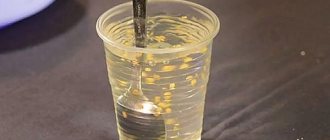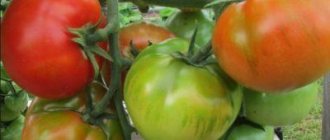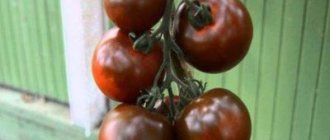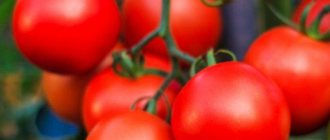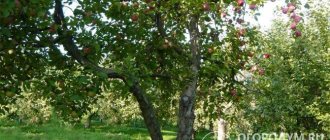Briefly about the main thing: description of the De Barao tomato
The variety “De Barao” was registered in the State Register in 2000. Basic characteristics of tomatoes:
- late-ripening (fruits ripen 115-130 days after emergence);
- indeterminate (stems without pinching can reach a height of 2-3.5 m);
- green leaves are large in size;
- the inflorescence is formed predominantly of a simple type, although intermediate types are found;
- Usually the first inflorescence is laid over the 9-11 leaf plate, and then they are repeated after 3 leaves;
- ovoid fruits (average weight - 30 g) with a smooth peel when ripe acquire a red tint;
- the stalk is formed with joints.
Types - how they differ
Scientists have developed many subspecies of De Barao, which differ somewhat in characteristics and descriptions. They differ according to the following characteristics:
- Fruit shape;
- tomato color;
- taste qualities.
Let's look at the varieties of De Barao tomatoes.
Pink
- After the shoots appear, pink tomatoes ripen in 115 days.
- The finally ripened fruits have a pleasant pink color.
- The yield of this variety of tomatoes is slightly less than others - up to 4 kg.
- The fruits weigh approximately 70 g.
- However, pink tomatoes have thick skins and a pleasant taste.
Advantages:
- Withstands slight frosts.
- Can grow in the shade.
- Good disease resistance.
- Stable harvest.
Red
- Tomatoes ripen 120-130 days after the first shoots appear.
- The main stem reaches up to 2 meters in height.
- The average weight of one fruit is 90 g.
- From one bush you can harvest about 4 kg of tomatoes.
- Plants develop well both in open ground and in a greenhouse.
The advantages of the species include the following qualities:
- develops well even in the shade;
- not exposed to diseases;
- withstands low air temperatures;
- The fruits are beautiful and have an excellent presentation.
The disadvantages include the fact that powerful bushes need to be pinched and excess leaf mass removed.
Red tomatoes are great for canning. If you combine them in one jar with a golden subspecies, the blank will look very beautiful.
Gold
- Golden De Barao has excellent taste.
- The fruits have a golden color.
- Ripens within 115 days.
- By autumn, up to 7 kg of golden fruits (also called yellow) are collected from 1 bush.
- The vegetable contains carotene in large quantities.
Advantages:
- Can develop in partial shade.
- Fruiting is high and stable.
- Not susceptible to disease.
- Tolerates low temperatures.
Flaws:
- Branched bushes are large.
- Excess green matter that should be removed.
Advantages and disadvantages
Considering its positive and negative qualities will help you evaluate the De Barao tomato:
| Advantages | Flaws |
| Resistance to diseases characteristic of tomatoes | Does not develop well if other tomato varieties are planted nearby |
| Long-term preservation of ripe fruits without loss of commercial qualities | Tall stems may be damaged by the weight of the fruit if reliable support is not installed |
| Fruiting lasts until the second ten days of October | Large area required for large bushes |
| Versatility in use for eating fresh fruits and as a raw material for canning | It is necessary to carry out pinching regularly |
| Good stamina | |
| Stable high yield | |
| A small number of nests inside the fruit (2-3 pcs.) | |
| Excellent taste |
Characteristics
Ripe fruits are bright orange in color, elongated and plum-shaped. The taste is pleasant, juicy with a strong aroma. Medium and small sized tomatoes 100-120 gr. The number of chambers is 2-3, the dry matter content is about 5-6%. The collected fruits can be stored for a long time and tolerate transportation well.
These tomatoes have a very high taste and are very good fresh. The fruits of "De Barao Orange" are perfect for whole-fruit canning and pickling. Some gardeners use them dried and frozen. Juices and pastes are usually not made, but cooking them is also possible.
You can compare the weight of the fruits of this variety with other varieties in the table:
| Variety name | Fruit weight |
| De Barao orange | 100-120 grams |
| Big Mama | 200-400 grams |
| Banana Orange | 100g |
| Honey saved | 200-600 grams |
| Rosemary pound | 400-500 grams |
| Persimmon | 350-400 grams |
| Dimensionless | up to 100 grams |
| f1 favorite | 115-140 grams |
| Pink flamingo | 150-450 grams |
| Black Moor | 50 grams |
| Early love | 85-95 grams |
Read more about diseases of tomatoes in greenhouses in the articles on our website, as well as about methods and measures to combat them. You will also be able to get acquainted with information about high-yielding and disease-resistant varieties, about tomatoes that are not at all susceptible to late blight.
In which regions of Russia can the “De Barao” tomato be grown?
If you follow basic agrotechnical rules, you can successfully cultivate De Barao tomatoes in different climatic conditions.
Ural
It will be possible to get a good harvest in the unstable climate characteristic of the Ural region by using seedling technology. Given the late fruiting, preference is given to cultivating “De Barao” in greenhouses.
Siberia
In Siberian territory, it is recommended to install greenhouses for seedlings of De Barao tomatoes, which will help to get a good harvest. If open beds are being established, the seedlings are moved into them in early June and be sure to install arcs with temporary film cover. It should be taken into account that a late-ripening variety may be affected by late blight at the end of August.
Tomatoes under temporary shelter
Moscow region and central Russia
In areas located in central Russia, the De Barao tomato can produce a good harvest in the beds if the seedlings are planted in late spring and be sure to install arches with film. To ensure abundant fruiting, it is practiced to move seedlings to greenhouses in the first ten days of May.
Southern regions of Russia
Since “De Barao” is a variety of late-ripening tomatoes, even in the south it is recommended to pre-grow seedlings, which are moved to the beds in April-May. This will allow you to collect high-quality, tasty fruits in August.
Planting tomato seeds
The sowing period for obtaining seedlings is determined depending on regional characteristics. In areas with variable, harsh climatic conditions of the North and Siberia, sowing is practiced until mid-February. For the southern regions, this operation is timed to coincide with the period from March 10 to March 20.
Seed preparation
In order to obtain high-quality friendly shoots, it is recommended to immerse the planting material in a solution that requires 1 tsp. fine salt. It must be diluted without sediment in a glass of slightly heated water. After 3-5 minutes, check the result. All grains accumulated on the surface must be thrown away. The liquid is drained, and the remaining seeds are washed with cool, purified water.
Soaking in saline solution
If the seed was prepared independently, it must be disinfected. For disinfection, use a pink solution of potassium permanganate. Immerse the grains for 25-30 minutes. Then you need to wash the seeds and dry them.
Sowing seedlings
You can use common seedling boxes. Fill them with loose substrate. It is more convenient to purchase it ready-made. On your own, you will need to combine crushed turf soil with well-rotted humus and loose peat. Be sure to spill the mixture with a raspberry solution of potassium permanganate.
Before sowing, furrows are made to a depth of about 20 mm, leaving a gap of 9-10 cm between them. The seeds are placed at intervals of 3-4 cm. Cover with soil and moisten. Place transparent glass on top or cover the container with film.
Keep in a bright room at +18…+24 °C. You can practice sowing in separate pots, placing 2-3 grains in each of them. This will then allow you to choose the healthiest sprout. The remaining shoots are carefully trimmed.
Hardening, picking seedlings
From common boxes, seedlings are distributed into cups after 1-3 leaves are formed. The spine is pinched a little. Seedlings grown in pots do not need to be picked.
1-1.5 weeks before the intended planting, it is recommended to transfer the seedlings to the loggia, veranda, or balcony during the day. First, keep it for about 1-2 hours. Then the hardening time needs to be extended daily.
Picking tomato seedlings
Landing in the ground
For high-quality development, De Barao tomatoes should choose an area with good lighting away from cold drafts. The soil required is nutritious and light.
You cannot plant the crop on the ridges after any plants from the Solanaceae family. In the fall, they dig up the earth, scattering it over the surface for every square meter. meter 0.5 cups of ash, 50 g of superphosphate granules and a bucket of rotted compost
Features of cultivation and storage
Seeds for seedlings are sown in peat tablets or a purchased soil mixture. You can prepare the soil yourself by adding compost, ash, sand, and peat to the garden turf soil. The mixture should be fertile and loose. To disinfect it, it is spilled with 1% potassium permanganate or calcined in the oven.
Sowing depth is 1.5-2 cm. Sprinkle with peat or mulch and tamp lightly.
How to care for seedlings:
- Before germination, the boxes are placed in warmth and light, covered with film or glass on top, as in a greenhouse;
- For watering use a spray bottle and warm water;
- apply liquid organic fertilizers or use “Krepysh”;
- dive when there are 3 true leaves.
Planting tomatoes with seedlings
To ensure good survival, seedlings should be transplanted onto the beds only after warm weather has established. The stable temperature should not be less than +15…+18 °C.
Preparing seedlings
Irrigation with stimulating compounds will help increase the immunity of young plants. A week before transplantation, use “Zircon” (0.1 ml/1 liter of settled water).
To make it easier for the seedlings to be removed from the cups, it is important to water the seedlings thoroughly in advance (1-2 hours before).
Rules for planting in open ground
For tall De Barao tomatoes, it is necessary to leave a gap of 0.6-0.9 m between the bushes.
A strong peg 2.6-3 m high is immediately driven into each planting hole. Pour in 2 tbsp. l. ash and high-quality loose compost. Bone meal will be beneficial, requiring 1 tsp. Glyokladin will help prevent an outbreak of fungal infections. Use 1 tablet per well.
Care
To obtain the expected harvest, it is important to correctly carry out the basic activities included in the care system for De Barao tomatoes.
Mulching and watering
Moisten tomato plantings regularly. It is important that water penetrates into the soil to a depth of about 35-45 cm. Irrigate with settled water after sunset. You can apply moisture in the morning. Leaves should be protected from dripping water. The frequency of watering depends on the weather. If a prolonged drought occurs, then liquid is required every 4-7 days.
It is recommended to cover tomato beds with a layer of mulch, which slows down evaporation and prevents the formation of a hard soil crust. They use chopped straw, hay, peat, and dried sawdust.
Bush formation and pinching
Indeterminate plants, which include the De Barao tomato, form many stepsons that need to be removed regularly.
To limit growth, pinch the top when the stem reaches 2 meters in height. They form bushes with 1-2 stems. The lower leaves are cut off after the ovaries have formed. Be sure to tie the stems to a support as they grow.
To achieve better stability with a bush height of 1.2 m, a box is installed around the perimeter. The length and height of its sides is about 50 cm. A nutrient substrate prepared in equal parts from sand, compost, crushed peat, rotted manure with the addition of 0.5 cups of ash is poured to the middle. This measure promotes the formation of additional roots.
Top dressing
The application of nutritional compositions begins 14-15 days after the seedlings have been moved to a permanent location. Apply mullein solution (1:20). You can add “Nitrophoska”. For dilution, take 50 g of fertilizer in 10 liters of settled water. Consumption - 1 l/bush.
After 2 weeks, developing tomato bushes will benefit from superphosphate (25 g), combined with a similar volume of potassium sulfate. Dissolve in a 10-liter tank of water. Consumption - 1 l/bush.
Then, after 14-15 days, use nitrophoska mixed with potassium humate. Take 15 g of each type of fertilizer per 10 liters of water. Consumption - 2.5 l/bush.
For the late-ripening variety “De Barao”, it is recommended to carry out a fourth feeding after half a month. For 10 liters of settled water, measure 1 tbsp. l. granulated superphosphate. Consumption - 5 l/bush.
Before adding nutrients, the soil is pre-moistened.
Variety varieties
As already noted, the De Barao tomato variety has several subspecies.
Black
Description
The De Barao tomato variety is indeterminate, mid-season, technical ripeness occurs 120-130 days after germination. Growth is unlimited; in a greenhouse it can be about three meters.
The inflorescences are represented by simple racemes with 8-10 fruits in the shape of an oval or egg. There are few cameras, no more than three. When technically ripe, the fruits are reddish-brown, as in the photo below.
The weight of individual fruits is 40-80 grams. Tomato De Barao Black, according to gardeners, is distinguished by dense, sweetish pulp. Thanks to the hard skin, they are easily transported and stored for a long time.
Pros and cons of the type
According to the characteristics of the De Barao Black tomato, the following positive aspects can be highlighted:
- high productivity;
- interesting appearance;
- excellent taste;
- versatility of use;
- transportability and keeping quality;
- resistance to late blight.
If we talk about the disadvantages, then these are:
- damage to fruits by black bacterial spot and blossom end rot;
- the inability of the plant to resist the Colorado potato beetle and slugs.
Attention! Preventive treatments for De Barao tomato will save the crop from destruction.
In addition to just Black De Barao, there is also De Barao Black Striped, here he is in the photo below.
Red
Another variety, the De Barao Red tomato variety, ripens in 120-130 days. It is indeterminate, up to 3 m high. That is why it is recommended to grow tomatoes in a greenhouse to avoid injury to the bush by winds.
Tomato De Barao A red productive variety, reviews from gardeners and the photo below confirm this. One bush, with proper care, will produce about 6 kg of tasty and dense egg-shaped fruits.
At technical ripeness, the tomatoes are bright red in color, the weight of individual tomatoes is from 80 to 120 grams. The fruits of the De Barao Red variety, according to reviews from gardeners and descriptions, are two- or three-chambered. They contain 5-6% dry matter.
If we talk about application, then in addition to fresh use, the fruits of the De Barao Red tomato (taking into account the description) are most often canned entirely: the size and dense skin allow it, which does not burst either on the bushes or when poured with boiling water.
Advantages
- attractive external data;
- cold resistance and endurance;
- excellent taste properties;
- high transportability;
- long shelf life;
- versatility of use;
- resistance to many diseases and pests of nightshade crops;
- excellent yield.
Flaws
- The impossibility of growing in open ground in the risky farming zone due to the medium-late ripening period. Greenhouses must be high enough.
- Difficulties in formation: only one or two stems, all other stepsons, as well as leaves, must be constantly removed.
- It is advisable to plant De Barao tomatoes separately from other varieties.
Pink
The plant belongs, like all varieties of De Barao, to indeterminate, tall (above 2 meters), varieties with a cluster type of fruiting. Technical ripeness occurs 115-125 days after planting. Tomatoes are intended for growing in a greenhouse.
The internodes of the De Barao Pink tomato are large, the stems are strong and powerful. The leaves are ordinary, dark green in color. The inflorescences are simple, compact in structure. The first of them appears quite high, above the 9th or 11th leaf. The next brushes are in increments of three sheets.
Attention! You need to grow a tomato with only one stem, removing all the stepsons.
The fruits are small, weighing from 50 to 70 grams, in the form of cream. The surface is smooth, the skin is dense, so cracking is not observed. The taste is normal tomato. At technical maturity, the De Barao tomato is pink, according to reviews and photos, bright pink. Fruits of universal use. Plants are resistant to tomato diseases.
Tsarsky
Tomatoes of this variety are mid-ripening (120-125 days), tall (up to two meters). The De Barao Tsarsky tomato is formed, judging by the description, into 1-2 stems; it needs support, tying, and pinching.
The type of inflorescence is carpal, with fruits resembling cream with a small pipette. The fruits are pale pink in color, with a barely noticeable golden crown on the peduncle.
Attention! According to consumer reviews, tomato is not suitable for whole-fruit canning due to its thin skin.
The fruits have a pronounced tomato taste. The weight of tomatoes is 50-100 grams. Fruiting is extended, the harvest is harvested until frost. Tomato De Barao Tsarsky is disease resistant.
Important! Tomatoes grow well even in the shade, and the yield does not suffer from this.
Gold
This variety is the result of amateur selection. The plant is late-ripening, indeterminate, which means it does not limit itself in growth. It can only be grown in protected soil.
The bushes are powerful with a large number of dark green leaves and shoots. This complicates care, since it requires constant planting of tomatoes. Experts and gardeners advise leaving only one stem.
The fruits of the De Barao Golden tomato, according to reviews, have an oval, plum-shaped shape. The surface is smooth. The weight of tomatoes is from 79 to 90 grams. The taste is excellent. When technically ripe, the fruits are golden-lemon in color.
Attention! De Barao Gold and Yellow are the same tomato.
The variety is productive; up to 6.5 kg of fruits are harvested from one bush with proper agricultural technology. This is also achieved due to the resistance of tomatoes to diseases of nightshade crops. As gardeners note in reviews, the De Barao Golden tomato practically does not suffer from late blight.
Comment! The density of the fruit allows the product to be transported over any distance, and the shelf life is high.
The yellow fruits are very healthy. Nutritionists note that they do not cause allergies and can lower blood pressure and cholesterol levels. They contain potassium, iron, magnesium, cobalt and zinc necessary for humans.
Orange
This variety was entered into the State Register only in 1999. Despite the short growing period, the De Barao Orange tomato has already become a favorite among Russian gardeners. The variety is of indeterminate type, powerful, late-ripening. The only thing that the originators pay attention to is that tomatoes do not have time to ripen in open ground; it is recommended to grow them only in greenhouses.
There are not too many leaves, they are rich green. The structure is normal, like all varieties of the variety.
The fruits are medium-sized, ovoid, weighing around 65 grams, with two or three chambers. The pulp is dense and juicy. Each cluster produces up to 8-10 bright orange fruits with a pleasant taste. According to the description (this can be seen in the photo), the tomatoes are equal in weight and shape.
Tomatoes are transportable and have a long shelf life. The purpose of the fruit is universal: fresh, for whole-fruit canning, salads, and making juice.
The yield is high (up to 8 kg per plant) if the bushes are grown in one stem. Plants almost never suffer from late blight, even if the summer is rainy.
Giant
Description
De Barao Giant tomatoes are distinguished by their power, up to 2 meters in height. Plants are cold-resistant, shade-tolerant. Recommended for growing in protected soil. Technical ripeness occurs in 125-130 days.
The plant is a raceme type; each cluster bears an average of 6-7 fruits, sometimes more. Average weight is from 70 to 100 grams. The shape of the fruit is cream. The pulp is dense with two or three chambers. Ripe fruits are red in color, and the cap in the area of the peduncle is greenish.
Advantages of the variety
Reviews about the Giant tomato are mostly rave. Gardeners call the main advantages:
- Stable yield.
- Great taste.
- Versatility of use.
- Long shelf life and transportability.
- High resistance to diseases of nightshade crops.
Growing the De Barao variety in a greenhouse
Since the De Barao tomato begins to bear fruit towards the end of summer, planting it in a greenhouse is considered the best option for growing it. You can get a good harvest if you follow a number of rules:
- For tall tomatoes you need a greenhouse of at least 3 meters.
- In the autumn season, not only the walls of the greenhouse, but also the soil are disinfected with Bordeaux mixture (1%).
- For powerful bushes, reliable trellises are installed.
- During the growing season, the greenhouse is regularly ventilated.
- Watering is practiced at the root, protecting the foliage from excess moisture.
Diseases and pests
Gardeners are attracted to the De Barao tomato variety by its resistance to major diseases. But, given the late fruiting, it is necessary to take measures to protect plantings from late blight.
Such drugs as “Proton” (20 g/10 l), “Ridomil Gold” (25 g/5 l), “Revus” (6 ml/5 l) are recognized as effective. They also successfully use “Ordan” (25 g/5 l), “Acrobat MC” (25 g/5 l), “Consento” (40 ml/10 l), “Quadris” (10 ml/10 l), “Abiga-pik” (50 g/10 l). It is important to irrigate tomato bushes at least 3-4 times during the growing season.
Late blight of tomatoes
Although De Barao tomatoes are surprising with the rare appearance of harmful insects, you need to regularly inspect the bushes.
Sometimes the mole cricket causes serious damage to them. Microgranular preparation “RembeK” (4.5 g / 10 m2) is used. If signs of spider mites are detected, apply Karbofos (30 g/5 l) before the flowering stage.
Spider mite
Video review of 4 subspecies of De Barao tomato variety
The author of the video describes the popular subspecies of the De Barao tomato: royal, giant, red and royal. The video demonstrates the appearance of the bush, fruits in general and in cross-section. Characteristics of taste and yield are given, and the average weight of tomatoes is indicated. Join the viewing!
To form your own opinion, it is worth planting different types of De Barao tomato. The experiment will be interesting. Perhaps, if the result is successful, this variety will be on the list of the most favorite types of popular culture.
Orange
- On average, this tomato fully ripens in 125 days.
- The height of the bush is about 3 meters.
- Very tasty tomatoes have the shape of a plum.
- Each fruit weighs up to 100 g.
- Thanks to the large amount of carotene found in these tomatoes, they have such a beautiful color.
- This species can be grown both in a greenhouse and in open areas.
- Tomatoes are used for making salads and for canning.
- With good care, almost 12 kg of tomatoes can be harvested from 1 bush. Moreover, the bush bears fruit before the onset of frost.
- Tomatoes have positive qualities that are found in all De Barao subspecies.
Black
The characteristics of this variety are practically no different from other De Barao tomatoes. However, these fruits are dark purple in color, almost black.
The weight of one fruit is 50 g.
Harvesting can begin 115 days after sprouts appear.
Striped
- This type of tomato has an oval shape.
- The weight of 1 fruit can reach 70 g.
- The ripe fruit is red with brown stripes.
- Tomatoes have excellent taste and are dense.
- They can be used for winter preparations.
- The striped subspecies is resistant to infection by diseases such as late blight.
Tsarsky
- The plant reaches a height of up to 250 cm.
- Up to 10 clusters are formed on it, on each of which about 7 light red fruits ripen.
- Each tomato weighs up to 130 g.
- This subspecies of De Barao is very fruitful. On average, 15 to 20 kg of tomatoes are harvested from 1 bush per season.
- Royal tomato seeds are difficult to buy, as they are among the rarest varieties of tomatoes.
Advantages:
- High yield and fruit production before the onset of frost.
- Not susceptible to fungal diseases.
- The harvested crop is stored for a long time.
- Used for preparing various dishes, as well as for canning.
- Withstands low air temperatures.
Flaws:
- It is necessary to install a strong support for the bush, which has a large and powerful stem.
- Requires timely removal of excess shoots and leaves.
Giant
- The main stem of this subspecies reaches 2 meters or more.
- The Giant's fruits are shaped like plums. Once ripe, they turn red and weigh about 150 g.
- One bush produces up to 6 kg of tomatoes.
- This tomato variety ripens later than all the subspecies of the De Barao variety.


